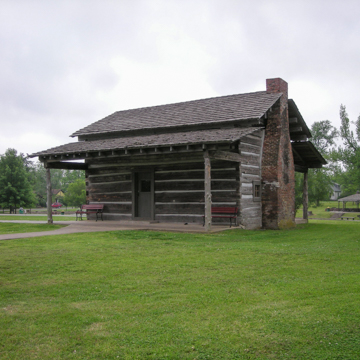Arthur Stilwell’s Arkansas Development Company planned the Mena townsite in 1896 around this four-block parcel containing a historic spring and an antebellum log cabin. In keeping with Stilwell’s custom of naming sites for himself or his investors, the park was named for the father-in-law of Jan DeGoeijen, the principal Dutch investor in the Kansas City, Pittsburgh and Gulf Railroad that came through Mena in 1897. The c. 1906 development of the space from an overgrown eyesore to a civic showplace complete with ponds, flower gardens, and a small zoo marked Mena’s transition from a tent city to a settled community. In the center stands one of the region’s oldest log dwellings, a single-pen pine structure with half-dovetail notching built in 1851 by William Shelton, one of the earliest settlers in this remote western Ouachita Mountains area. The cabin’s original clay (or “mud-cat”) chimney, once common in southern Arkansas, was replaced by a brick one in the 1870s and reconstructed using the same bricks by the PWA in 1933. When the railroad was under construction, the cabin served as the surveyor’s office and from World War I until after World War II as Mena’s city hall. Near the log cabin and as the centerpiece of the park is the picturesque Boy and Girl Fountain installed in 1914. The 3.5-foot bronze sculpture of a pair of children under an umbrella sits on a concrete base. Manufactured by the E. T. Barnum Wire and Iron Works foundry of Detroit, the ensemble is of unusually fine quality for a small Arkansas town. Despite the destruction of most of its large trees in a 1993 tornado (many since replanted), the park is a popular site for weddings, political rallies, and family reunions.
You are here
Janssen Park
If SAH Archipedia has been useful to you, please consider supporting it.
SAH Archipedia tells the story of the United States through its buildings, landscapes, and cities. This freely available resource empowers the public with authoritative knowledge that deepens their understanding and appreciation of the built environment. But the Society of Architectural Historians, which created SAH Archipedia with University of Virginia Press, needs your support to maintain the high-caliber research, writing, photography, cartography, editing, design, and programming that make SAH Archipedia a trusted online resource available to all who value the history of place, heritage tourism, and learning.


